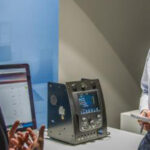Surprisingly, the invention of windshield wipers for cars was made by a regular woman named Mary Anderson, an American, in 1903.
>> Rear View mirror – The story of the 1900s
>> Replacing windshield wipers – Simple but essential
While driving in New York City in 1903, Mary Anderson noticed that drivers often had to stop their cars and manually wipe away water and snow from their windshields. Some even resorted to sticking their heads out of the window due to the thick snow. From a woman’s perspective, she recognized the need for a device that could help drivers clear their windshields without stopping the car.

Back at home, Anderson designed the first windshield wiper system. However, when she presented her idea, she faced ridicule because people believed it was a man’s job, and her idea was considered “crazy.”
In 1905, Anderson received a patent in the United States, demonstrating the intellectual prowess of women. She was 39 years old at the time.
The operation of her device was simple. Anderson utilized two blades attached to the car body, which made contact with the windshield using a rubber “blade.” When needed, the driver could turn a handle inside the cabin. Through a transmission mechanism, the two windshield wiper blades moved up and down, clearing away snow and water, providing the driver with clear visibility.

However, car manufacturers did not immediately embrace her invention. It wasn’t until 1916, 11 years later, that windshield wipers became a standard feature in all US cars. Anderson owed her recognition to Henry Ford, as the mass production technology of the Model T made cars more affordable for consumers and her invention more widely known.
During that time, electric motors were not yet used in cars. Consequently, Anderson’s windshield wipers had their limitations, as the driver had to manually operate them, leaving only one hand to steer, shift gears, and apply the handbrake, if necessary.
It wasn’t until 1917 that electric motors were introduced to move a long rubber blade back and forth on the windshield. Dr. Ormand Wall, a dentist from Hawaii, invented an automatic windshield wiper by placing an electric motor on top and in the middle of the windshield. This arrangement caused the rubber blade to move in a circular motion, with the center positioned above and the swept area resembling an upside-down rainbow.

A windshield washing system was later added, with the control part directly integrated into the windshield wiper’s on/off lever. This part would spray washer fluid onto the windshield, via small holes on the hood cover, providing further cleaning. A water reservoir was placed in the engine compartment, and other electrical components were connected to perform this task.
In 1962, Bob Kearns invented the first intermittent windshield wiper, allowing drivers to adjust the speed of the sweep and the pause time between each sweep. This innovation introduced fuses and electrical circuit breakers into the electrical system, providing more flexibility in operating electrical components.
In the 1980s, windshield wipers were also developed for headlights, requiring careful calculation of the linkage between the lighting system and the windshield washing and wiping system.

From the 1990s until now, windshield wipers have continued to evolve alongside car technology. Sensor components are now directly attached to the windshield, allowing rain detection and activation of the automatic windshield wiper system, adjusting the wiper speed based on the intensity of the raindrops.
Th? Ð?t (TTTÐ)
Exciting Activities Await at the Vietnam Car Interior New Year Party
The 2023 New Year’s Eve Party hosted by the Vietnam Automobile Interior Association will take place on December 21, 2023 at Louis Palace, Le Trong Tan, Ha Dong, Hanoi. This event is considered the largest gathering of the automotive accessories community in Vietnam, attracting approximately 1,500 participants.














































